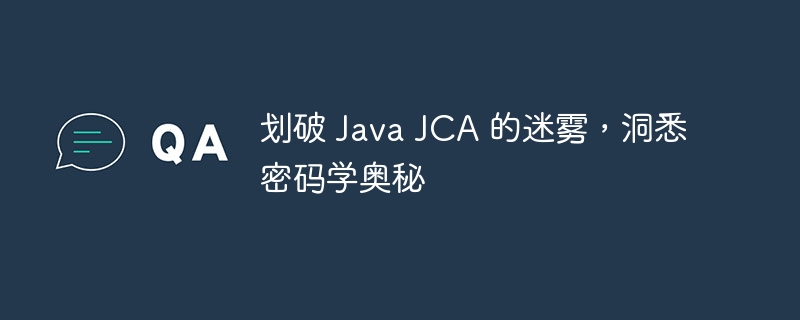Home >Java >javaTutorial >Break through the fog of Java JCA and gain insight into the mysteries of cryptography
Break through the fog of Java JCA and gain insight into the mysteries of cryptography
- 王林forward
- 2024-03-14 17:10:141300browse

php editor Zimo takes you to explore the cryptographic mysteries of Java JCA (Java Cryptography Architecture). Cryptography is the core of the information security field, and Java JCA, as the encryption framework of the Java platform, involves many complex encryption algorithms and technologies. This article will unveil the mystery of Java JCA and help you understand its mysteries and practical applications. Let us cut through the fog together and reveal the essence of cryptography!
JCA Architecture is divided into three main components:
- Security Service Provider (SSP): Provides specific cryptographic services such as encryption, decryption, signing, and verification.
- Provider Factory: Create and manage SSPs.
- Algorithm parameters: Specify specific parameters of the password algorithm, such as key length and padding mode.
Encryption Algorithm
JCA supports multiple encryption algorithms, including:
- Symmetric encryption: Use the same key for encryption and decryption, such as AES and DES.
- Asymmetric encryption: Use a pair of public and private keys for encryption and decryption, such as RSA and ECC.
- Hash function: Generates a fixed length, used for data integrity and authentication, such as SHA and MD5.
- Key Agreement: Generate keys for use in secure communications such as Diffie-Hellman and ElGamal.
Services and Utilities
In addition to encryption algorithms, JCA provides a variety of services and utilities, including:
- Key generation: Generate encryption keys.
- Key Management: Store, retrieve and manage encryption keys.
- Message: Calculated data, used to verify its integrity.
- Digital Signature: Create and verify digital signatures to verify the origin and integrity of data.
- Digital Certificates: Store and manage digital certificates for authentication and establishing secure communications.
Integration and use
Integrating JCA is very simple. Developers can use the following steps:
- Import the necessary Java packages (e.g.
javax.crypto). - Instantiate the SSP you wish to use.
- Get algorithm parameters and initialize encryption operations.
- Perform encryption or decryption operations.
Safety considerations
When using JCA, it is important to follow best security practices, including:
- Use strong cryptographic algorithms and key lengths.
- Securely store and manage encryption keys.
- Verify digital signatures to ensure data integrity and origin.
- Regularly update the JCA implementation to fix vulnerabilities.
Advantage
Using JCA provides the following advantages:
- Convenience: The abstraction layer simplifies the implementation of cryptographic tasks.
- Modularity: The pluggable SSP architecture allows easy integration of new cryptographic algorithms and services.
- Portability: JCA is available on all Java platforms, ensuring consistent cryptographic operations across platforms.
- Standardization: Compliance with JCA specifications ensures interoperability among different vendors.
Application scenarios
JCA is critical in a variety of application scenarios, including:
- Secure Communications: Encrypt emails, messages and network traffic.
- Authentication and Authorization: Verify user identity and authorize access to protected resources.
- Data Protection: Encrypt sensitive data to prevent unauthorized access.
- Finance and e-commerce: Protect the integrity and confidentiality of online transactions.
- Digital Signature: Verify the authenticity and integrity of the document.
The above is the detailed content of Break through the fog of Java JCA and gain insight into the mysteries of cryptography. For more information, please follow other related articles on the PHP Chinese website!

